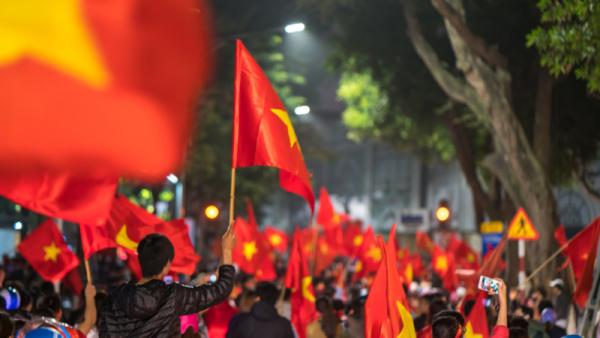Vietnam’s pivot
Vietnam Stock Images / Shutterstock

Marina Zhang, Associate Professor – Research, Australia-China Relations Institute, University of Technology Sydney |
Note: This article appeared in The Interpreter on January 15 2024.
Vietnam has recently emerged as a geopolitical linchpin, adeptly navigating the intricate power dynamics between the United States and China. US President Joe Biden’s September visit to Vietnam, elevating bilateral relations to a ‘comprehensive strategic partnership’, symbolised the US view of Vietnam as a potential ally in counterbalancing China. Concurrently, Vietnam has also strengthened its ties with Beijing, as seen in China’s President Xi Jinping’s visit last month, where both countries agreed to enhance cooperation and rail connectivity.
Known for its ‘bamboo diplomacy’ – a flexible yet deeply rooted approach – Vietnam’s strategy underscores the nuanced complexities of Southeast Asian geopolitics. Amid the global rivalry for control of critical supply chains, Vietnam’s role becomes increasingly pivotal.
To attain high-income status by 2045, Vietnam needs advanced technologies from the United States and infrastructure support from China, and currently, it appears to have access to both.
Despite differing political ideologies, the United States sees strategic alignment with Vietnam, particularly in high-tech sectors such as semiconductors. Biden’s visit likely signals to US corporations, including Intel, Nvidia, and Apple, that investment in Vietnam’s emerging tech hub is encouraged. In 2022, US foreign direct investment (FDI) in Vietnam was $0.5 billion, ranking as the tenth largest source. There’s anticipation for substantial growth in US investment in the coming years by American tech giants.
Conversely, China’s commitment to Vietnam’s infrastructure, especially through the upgrade of the Kunming-Haiphong railway link, aligns with Vietnam’s economic transformation goals. This project, part of the Pan-Asia Railway network, aims to enhance Vietnam’s manufacturing hub status. In 2022, China’s FDI in Vietnam, the fourth after South Korea, Singapore and Japan, amounted to $1.7 billion, bringing the total from 2019 to 2022 to $7.4 billion. These investments span information communications technology, new energy, green technology, and e-commerce logistics sectors. Following Xi’s visit, the renewed Greater Mekong Subregion Cross-Border Transport Facilitation Agreement further cements regional integration aspirations.
The contest for control over critical minerals adds another layer to this trilateral dynamic. Vietnam, home to the world’s second-largest rare earth reserves, becomes strategically significant in the US-China rivalry. While Washington views Vietnam as a prospective partner in rare earth mining, aiming to reduce dependence on China, Beijing seeks to maintain its dominance in the rare earth value chain. The recent diplomatic engagements suggest potential collaborative opportunities in rare earths between China and Vietnam, serving mutual interests in counterbalancing US influence.
Vietnam’s ascent in the global supply chain is marked by a series of challenges, reflecting its nuanced role in the shifting economic landscape.
Vietnam’s current position is predominantly as a complementary extension to China’s mega supply chains rather than a direct competitor or alternative. The growth in Vietnam’s exports to the United States, alongside its imports from China, paints a picture of a nation deeply embedded in processing trade. In 2022, while Vietnam’s exports accounted for over 10% of China’s total, its net exports constituted mere 1% of China’s, underlining its role in the trans-shipment of goods primarily from China to the United States.
Thus, Vietnam’s position in the broader US-led ‘China Plus One‘ de-risking strategy appears to be of a secondary nature. As such, Vietnam is more likely to remain a complementary cog within the global supply chain networks, bridging the gap between upstream suppliers and manufacturers in China and consumer markets in the West. This intermediary role, while crucial, underscores Vietnam’s challenges in transitioning from a processing hub to a key player with its own technological and industrial sovereignty.
Vietnam’s economic growth has been significantly driven by foreign direct investment, yet the country faces an uphill battle in moving up the global value chain. The lack of strong domestic brands and indigenous technological capabilities is a bottleneck. The scenario in 2022, where foreign-invested enterprises made up around three-quarters of Vietnam’s export value, mirrors China’s industrial landscape two decades ago, highlighting a familiar developmental trajectory.
Numerous nations, caught in the crossfire of superpower rivalries, are opting for a cautious path, forging ties with both Washington and Beijing. This approach, typified by Vietnam, entails a diversification of alliances across economic, security, and political spheres, avoiding exclusive commitments to either superpower.
Vietnam’s strategy, while beneficial in the current scenario, carries significant implications for its future and the geopolitical fabric of Southeast Asia. Its increasing importance in the global supply chain, particularly in manufacturing and technology sectors, hinges on the region’s continued stability and peace.
However, rising tensions, notably in the Taiwan Strait and the South China Sea, coupled with internal challenges in both the United States and China, are contributing to a climate of uncertainty in Southeast Asia. This volatility could threaten Vietnam’s strategic positioning. Internally, the sustainability of Vietnam’s foreign policy is contingent on maintaining political stability and garnering public support. Economic disparities, human rights concerns, and political dissent present additional challenges to its diplomatic manoeuvring.
Should regional stability deteriorate, or domestic unrest escalate, foreign companies – crucial to Vietnam’s economic progression – might reassess their operations, potentially relocating due to shifting geopolitical ties or security considerations. Such a development could leave Vietnam economically vulnerable, especially if it hasn’t developed strong domestic technological firms integrated into global supply chains.
Vietnam’s situation highlights a broader issue facing countries heavily dependent on foreign investment for technological and economic growth. As the era of globalisation gives way to an age of technological fragmentation and heightened competition for control of critical technologies and minerals, geopolitical uncertainty has become an increasingly prominent risk in the global supply chain landscape. Unpredictable geopolitical uncertainty requires businesses and nations to re-evaluate their approaches to supply chain security and resilience.
Author
Dr Marina Zhang is Associate Professor – Research at the Australia-China Relations Institute, University of Technology Sydney.

